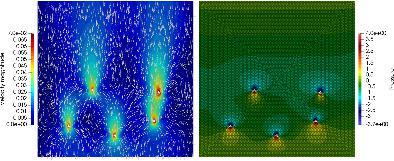当前位置:
X-MOL 学术
›
Int. J. Numer. Methods Fluids
›
论文详情
Our official English website, www.x-mol.net, welcomes your
feedback! (Note: you will need to create a separate account there.)
Using a deep neural network to predict the motion of underresolved triangular rigid bodies in an incompressible flow
International Journal for Numerical Methods in Fluids ( IF 1.7 ) Pub Date : 2021-08-12 , DOI: 10.1002/fld.5037 Henry von Wahl 1 , Thomas Richter 1
International Journal for Numerical Methods in Fluids ( IF 1.7 ) Pub Date : 2021-08-12 , DOI: 10.1002/fld.5037 Henry von Wahl 1 , Thomas Richter 1
Affiliation

|
We consider nonspherical rigid body particles in an incompressible fluid in the regime where the particles are too large to assume that they are simply transported with the fluid without back-coupling and where the particles are also too small to make fully resolved direct numerical simulations feasible. Unfitted finite element methods with ghost-penalty stabilization are well suited to fluid-structure-interaction problems as posed by this setting, due to the flexible and accurate geometry handling and for allowing topology changes in the geometry. In the computationally underresolved setting posed here, accurate computations of the forces by their boundary integral formulation are not viable. Furthermore, analytical laws are not available due to the shape of the particles. However, accurate values of the forces are essential for realistic motion of the particles. To obtain these forces accurately, we train an artificial deep neural network using data from prototypical resolved simulations. This network is then able to predict the force values based on information which can be obtained accurately in an underresolved setting. As a result, we obtain forces on very coarse and underresolved meshes which are on average an order of magnitude more accurate compared with the direct boundary-integral computation from the Navier–Stokes solution, leading to solid motion comparable to that obtained on highly resolved meshes that would substantially increase the simulation costs.
中文翻译:

使用深度神经网络预测不可压缩流中解析不足的三角形刚体的运动
我们考虑不可压缩流体中的非球形刚体粒子,其中粒子太大而无法假设它们在没有反向耦合的情况下与流体一起简单传输,并且粒子也太小而无法进行完全解析的直接数值模拟。由于灵活和准确的几何处理以及允许几何中的拓扑变化,具有重影稳定性的未拟合有限元方法非常适合由这种设置引起的流固耦合问题。在此处提出的计算不足的设置中,通过边界积分公式准确计算力是不可行的。此外,由于粒子的形状,分析定律不可用。然而,力的准确值对于粒子的真实运动至关重要。为了准确地获得这些力,我们使用来自原型解析模拟的数据训练人工深度神经网络。然后,该网络能够根据可以在解析不足的环境中准确获得的信息来预测力值。因此,我们在非常粗糙和解析不足的网格上获得了力,与 Navier-Stokes 解的直接边界积分计算相比,这些力平均要准确一个数量级,导致固体运动与在高分辨率网格上获得的运动相当这将大大增加模拟成本。然后,该网络能够根据可以在解析不足的环境中准确获得的信息来预测力值。因此,我们在非常粗糙和解析不足的网格上获得了力,与 Navier-Stokes 解的直接边界积分计算相比,这些力平均要准确一个数量级,导致固体运动与在高分辨率网格上获得的运动相当这将大大增加模拟成本。然后,该网络能够根据可以在解析不足的环境中准确获得的信息来预测力值。因此,我们在非常粗糙和解析不足的网格上获得了力,与 Navier-Stokes 解的直接边界积分计算相比,这些力平均要准确一个数量级,导致固体运动与在高分辨率网格上获得的运动相当这将大大增加模拟成本。
更新日期:2021-08-12
中文翻译:

使用深度神经网络预测不可压缩流中解析不足的三角形刚体的运动
我们考虑不可压缩流体中的非球形刚体粒子,其中粒子太大而无法假设它们在没有反向耦合的情况下与流体一起简单传输,并且粒子也太小而无法进行完全解析的直接数值模拟。由于灵活和准确的几何处理以及允许几何中的拓扑变化,具有重影稳定性的未拟合有限元方法非常适合由这种设置引起的流固耦合问题。在此处提出的计算不足的设置中,通过边界积分公式准确计算力是不可行的。此外,由于粒子的形状,分析定律不可用。然而,力的准确值对于粒子的真实运动至关重要。为了准确地获得这些力,我们使用来自原型解析模拟的数据训练人工深度神经网络。然后,该网络能够根据可以在解析不足的环境中准确获得的信息来预测力值。因此,我们在非常粗糙和解析不足的网格上获得了力,与 Navier-Stokes 解的直接边界积分计算相比,这些力平均要准确一个数量级,导致固体运动与在高分辨率网格上获得的运动相当这将大大增加模拟成本。然后,该网络能够根据可以在解析不足的环境中准确获得的信息来预测力值。因此,我们在非常粗糙和解析不足的网格上获得了力,与 Navier-Stokes 解的直接边界积分计算相比,这些力平均要准确一个数量级,导致固体运动与在高分辨率网格上获得的运动相当这将大大增加模拟成本。然后,该网络能够根据可以在解析不足的环境中准确获得的信息来预测力值。因此,我们在非常粗糙和解析不足的网格上获得了力,与 Navier-Stokes 解的直接边界积分计算相比,这些力平均要准确一个数量级,导致固体运动与在高分辨率网格上获得的运动相当这将大大增加模拟成本。











































 京公网安备 11010802027423号
京公网安备 11010802027423号